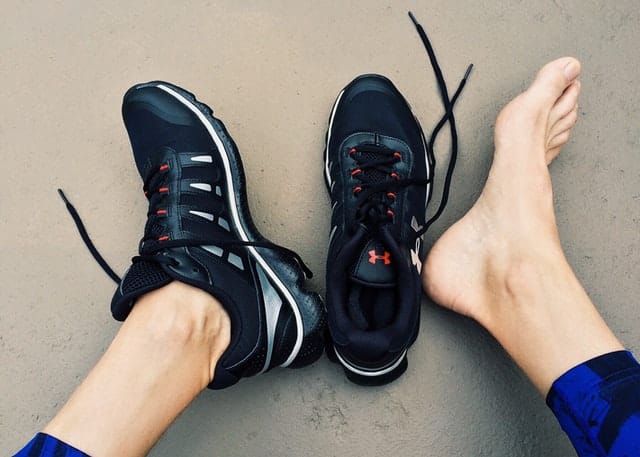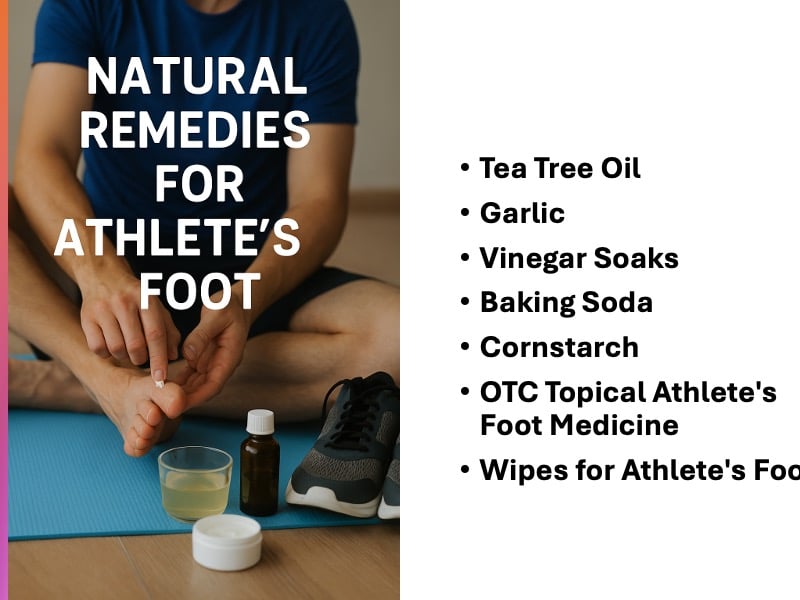How to Treat Athlete’s Foot at Home, Naturally & Fast!
Learning how to treat athlete’s foot at home can save you time, money, and unnecessary discomfort, especially if you’re looking for fast, natural solutions that actually work.
Athlete’s foot, or tinea pedis, is a common fungal infection that thrives in warm, moist environments like gym shoes, locker rooms, and even your own socks after a long day.
From mild itching and peeling skin to painful cracks and stubborn rashes, the symptoms of athlete’s foot can escalate quickly if not addressed with proper care.
The good news?
Many natural remedies for athlete’s foot are accessible, effective, and safe to use at home, with no prescription required!
As someone who’s trained and competed in damp, high-performance shoes for over a decade, I’ve learned firsthand how important it is to act early.
The right home treatment for athlete’s foot can speed up healing, reduce itching and burning, and help prevent the infection from spreading to your toenails or other areas.
In this guide, you’ll discover the best DIY remedies for athlete’s foot, such as how to use essential oils, natural antifungals, and practical hygiene habits to prevent athlete’s foot!
What Is Athlete’s Foot?
Athlete’s foot, medically known as tinea pedis, is a contagious fungal infection that typically begins between the toes and thrives in warm, moist environments.
What Causes Athlete’s Foot?
Athlete’s foot is caused by dermatophytes, a group of fungi that feed on keratin found in the skin, nails, and hair.
Symptoms of Athlete’s Foot
Common symptoms of athlete’s foot include itching, burning, stinging sensations, and flaky or cracked skin, particularly in the webbing of the toes or on the soles of the feet.
In more severe cases, it can also lead to blisters, ulcers, or secondary bacterial infections if left untreated.
Who Does Athlete’s Foot Affect Most Commonly?
This condition often affects athletes, gym-goers, and individuals who wear tight or damp shoes for extended periods, but it can happen to anyone.
Walking barefoot in communal spaces like locker rooms, public showers, and swimming pool decks increases the risk of exposure.
Recognizing and treating athlete’s foot early is essential not only for symptom relief but also to prevent it from spreading to other parts of the body, including the toenails (onychomycosis) and hands (tinea manuum).
How to Prevent Athlete’s Foot

Preventing athlete’s foot starts with creating a dry, clean, and well-ventilated environment where fungus can’t thrive.
Since athlete’s foot is highly contagious, even a quick walk across a locker room floor or slipping into damp shoes can invite an outbreak.
For athletes, gym-goers, and anyone who spends long hours in shoes or on their feet, foot hygiene isn’t just about avoiding odor, it’s a first line of defense against fungal infections.
By practicing simple daily habits and making smart footwear choices, you can dramatically reduce your risk of dealing with itchy, burning, or cracked skin caused by athlete’s foot.
The steps below focus on proactive foot care, proper shoe management, and antifungal hygiene practices that can help you stay one step ahead of this frustrating condition.
Keep Feet Dry and Clean
Before you begin treating athlete’s foot with any products, the first step is to make sure that it cannot spread any further.
To do so, the main step you want to take is drying your feet often.
Since warm and damp areas are great for the fungus to thrive, you need to maintain dry feet throughout the day.
Wearing dry shoes is important, but you want to focus on making sure that your socks are always dry.
If possible, alternate the pair of shoes you wear each day.
Additionally, if you can, avoid wearing shoes made of synthetic-based materials such as rubber or plastic because they are more likely to cause your feet to sweat, creating a warm and damp atmosphere for the fungus to thrive.
You can wear any type of socks that you want, but compression socks are particularly effective for keeping your feet dry and preventing athlete’s foot.
There are a variety of different benefits of wearing compression socks, but one of the lesser-known benefits is that they can help prevent athlete’s foot.
Most compression socks are good for wicking away moisture, but copper compression socks are especially useful.
Copper is a potent antimicrobial agent, and it kills a variety of bacteria, viruses, and fungi on contact.
Additionally, copper assists with the production and stabilization of skin proteins, helping your feet get healthy and stay healthy.
Here is a great example of copper compression socks you can use for preventing athlete’s foot:
Last update on 2025-11-20 / This article includes affiliate links/Images via Amazon Product Advertising API. I may earn commissions on purchases made through these links.
Wear Breathable Footwear
Choosing the best workout shoes made from materials that allow air circulation is a key to preventing athlete’s foot. Avoid wearing the same pair of shoes consecutively to let them dry out.
Change Socks Regularly
Wear moisture-wicking socks and change them daily or more frequently if they become damp.
Use Antifungal Powders or Sprays
Antifungal powders and sprays can help keep your feet dry and reduce the risk of fungal growth.
Last update on 2025-11-20 / This article includes affiliate links/Images via Amazon Product Advertising API. I may earn commissions on purchases made through these links.
Protect Your Feet in Public Areas
Wear sandals or shower shoes in public showers, locker rooms, and around public pools.
Avoid Sharing Footwear
Fungi can spread by direct contact, so avoid sharing shoes and socks.
Maintain Good Foot Hygiene
Regularly trim your toenails and keep them clean, as fungi can live under nails.
Control Foot Perspiration
If you have sweaty feet, consider using specialized insoles that absorb moisture and keep feet drier.
Choose the Right Socks
Opt for socks made from natural fibers like cotton or wool, or synthetic fibers designed to wick away moisture.
Avoid Tight-fitting Shoes
Tight footwear can create a moist, warm environment conducive to fungal growth.
Home Remedies for Athlete’s Foot

Although you can order prescription medication online for treating athlete’s foot, you can also use home remedies or over-the-counter athlete’s foot medicines.
Keep reading below to find a few of the best solutions for treating athlete’s foot at home!
Tea Tree Oil
Known for its antifungal and antiseptic properties, tea tree oil can be applied to the affected area.
It’s important to dilute the oil with a carrier oil, like coconut or olive oil, to avoid skin irritation (Carson et al., 2006).
Garlic
Garlic contains a compound called ajoene, which has antifungal properties.
Crushed garlic can be applied to the affected area or used in foot soaks.
However, direct application might cause skin irritation in some individuals.
Vinegar Soaks
Soaking feet in a mixture of vinegar and water may help treat athlete’s foot.
The acidic nature of vinegar can create an environment less favorable for the fungus.
A common ratio is one part vinegar to two parts water.
Baking Soda
Baking soda can be used in foot soaks or as a paste.
It’s believed to have antifungal qualities and also helps in absorbing moisture, which fungi thrive on.
Cornstarch
Applying cornstarch, which absorbs moisture, can help keep the feet dry and prevent the growth of fungus. It’s best used after the feet are thoroughly cleaned and dried.
While these home remedies may offer relief, they are not a substitute for professional medical advice. If symptoms persist or worsen, it’s important to consult a healthcare professional.
OTC Topical Athlete’s Foot Medicine
If you want to treat athlete’s foot at home and without the help of prescription medicine, an over-the-counter topical medicine will probably be very effective for you.
Make sure you wash your hands before using the medicine and make sure your feet are completely dry before applying it.
Lotrimin is the most famous brand for OTC athlete’s foot medicine, and it has been successfully used for years by people with athlete’s foot.
Last update on 2025-11-20 / This article includes affiliate links/Images via Amazon Product Advertising API. I may earn commissions on purchases made through these links.
Wipes for Athlete’s Foot
If you don’t like the idea of using a cream such as Lotrimin, another at-home remedy for athlete’s foot is to use antifungal wipes.
You can even get antifungal wipes that contain only natural essential oils or other natural products.
These wipes are great because you can use them for other purposes as well, and not just athlete’s foot.
Although they may be less effective than an OTC athlete’s foot medicine like Lotrimin, they are multi-purposed and effective as well.
Last update on 2025-11-20 / This article includes affiliate links/Images via Amazon Product Advertising API. I may earn commissions on purchases made through these links.
Final Thoughts: Keys to Treating Athlete’s Foot at Home
Treating athlete’s foot at home naturally and effectively requires consistency, hygiene, and the right antifungal strategies.
Whether you’re using tea tree oil, soaking your feet in apple cider vinegar, or applying over-the-counter creams, the key is staying diligent until symptoms are fully gone, and continuing with prevention afterward.
Focus on keeping your feet clean and dry, rotating your footwear, and avoiding going barefoot in shared spaces.
When treated early and managed properly, most cases of athlete’s foot can be resolved at home without medical intervention.
And remember, if symptoms persist beyond a couple of weeks or worsen, it’s best to consult a podiatrist or dermatologist for stronger antifungal treatment or further evaluation.
This website does not provide medical advice. This website site does contain affiliate links, and purchases may earn a commission.
Read my Medical Disclaimer, Review Disclaimer, and Publishing Policies for more details. Use of this site indicates acceptance of these terms.







